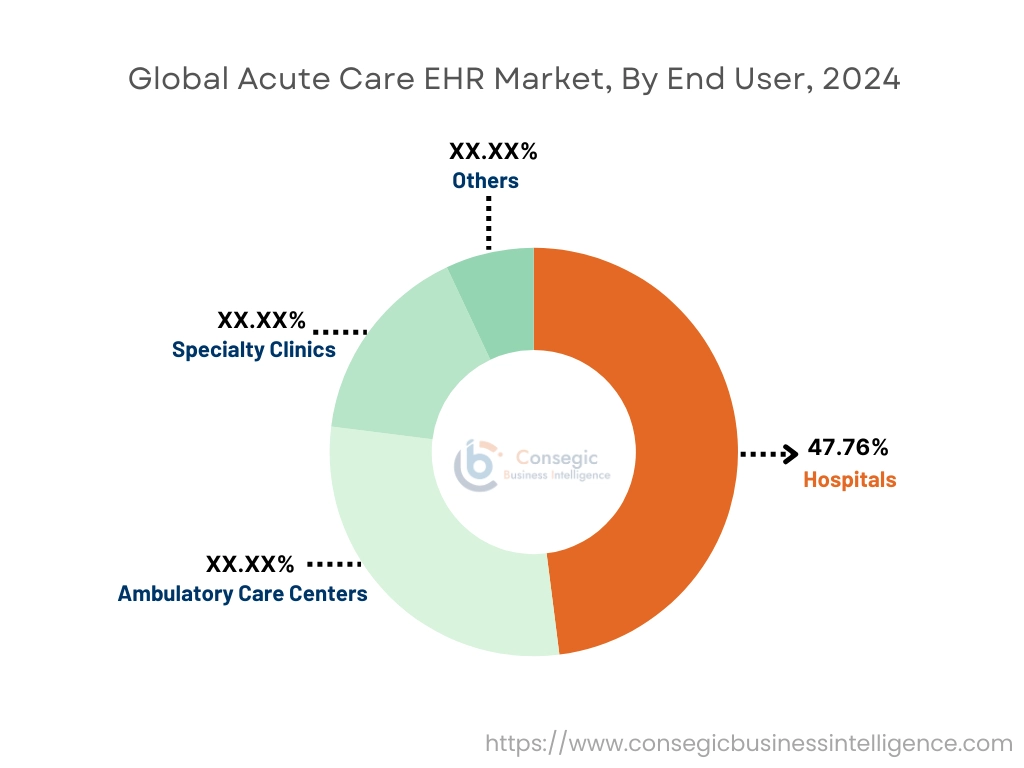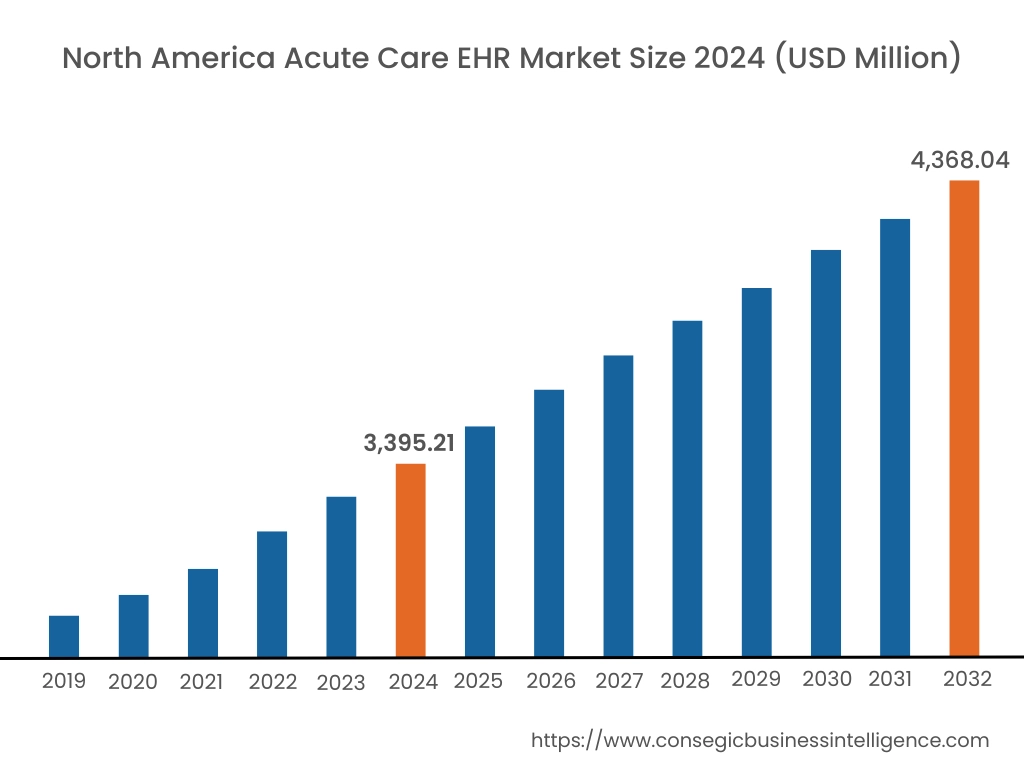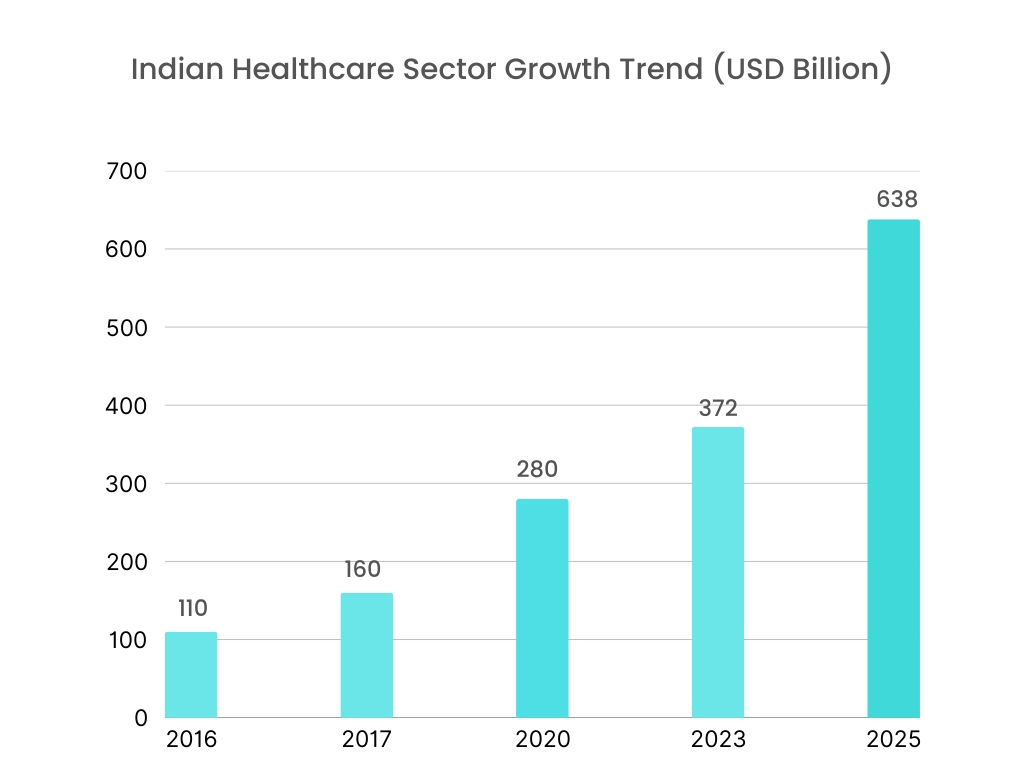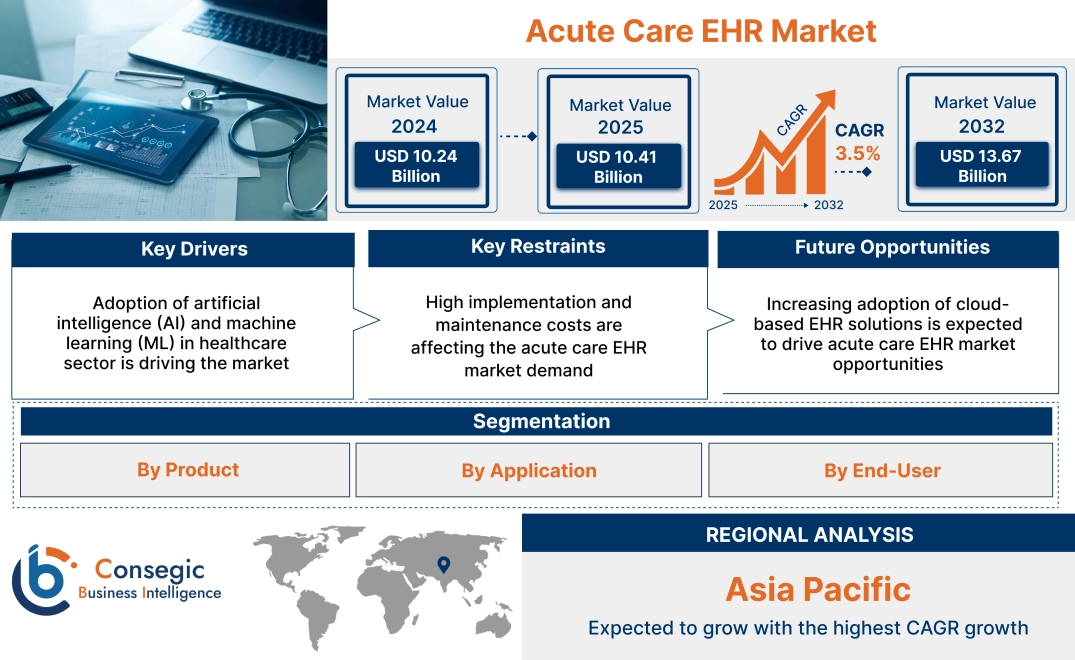Acute Care EHR Market Size:
Acute Care EHR Market Size is estimated to reach over USD 13.67 Billion by 2032 from a value of USD 10.24 Billion in 2024 and is projected to grow by USD 10.41 Billion in 2025, growing at a CAGR of 3.5% from 2025 to 2032.
Acute Care EHR Market Scope & Overview:
An acute care electronic health record (EHR) system is a digital platform used in hospitals and other acute care settings to store, manage, and share patient health information. It is a digital version of a patient's paper chart, providing instant access to medical histories, diagnoses, treatment plans, and other relevant data. The primary benefits include improved patient care, enhanced data accuracy, reduced medical errors, and increased efficiency in clinical operations. Key applications include patient monitoring, medication management, and diagnostic support, catering to end-users like hospitals, emergency care centers, and specialized acute care facilities.
Acute Care EHR Market Dynamics - (DRO) :
Key Drivers:
Adoption of artificial intelligence (AI) and machine learning (ML) in healthcare sector is driving the market
The advancements in technology and adoption of ML and AI in healthcare sector are providing a substantial boost to the global market. These technologies enable predictive analytics, which can lead to better patient management and treatment outcomes. These technologies are increasingly integrated into EHR systems to offer more personalized healthcare solutions, thereby, driving the market growth. Furthermore, the rise of telemedicine and remote patient monitoring solutions, which rely heavily on EHR systems for efficient data management, is contributing to the market development.
- For instance, in October 2024, Oracle unveiled next-generation EHR, which is embedded with AI across entire clinical workflows. By seamlessly connecting with various Oracle health applications, the EHR aims to make information sharing easier between insurance companies and healthcare providers. It is also built to assist with finding patients for research studies, simplify following regulations, improve financial outcomes, and speed up the shift towards value-based healthcare.
Thus, according to the global market, the adoption of artificial intelligence and machine learning in healthcare sector is driving the acute care EHR market size and trends.
Key Restraints:
High implementation and maintenance costs are affecting the acute care EHR market demand
The market faces significant challenges due to high costs associated with implementation and ongoing maintenance. Setting up a comprehensive EHR system requires substantial investments in software, hardware, and IT infrastructure, which can be prohibitive for small and mid-sized acute care facilities. Additionally, the need for regular software updates, cybersecurity measures, and system maintenance adds to the overall expense, making it difficult for resource-constrained hospitals to adopt EHR solutions. These financial barriers, combined with the complexity of EHR integration with existing healthcare systems, limit the widespread adoption of acute care EHR systems, particularly in developing regions. Thus, the analysis depicts that the aforementioned factors would further impact the acute care EHR market size.
Future Opportunities :
Increasing adoption of cloud-based EHR solutions is expected to drive acute care EHR market opportunities
The increasing adoption of cloud-based EHR solutions is providing healthcare service providers with greater flexibility, scalability, and cost-effectiveness. As more healthcare organizations shift towards cloud-based models, there is a potential prospect for vendors to develop innovative solutions that address the specific needs of acute care settings. Additionally, the integration of advanced technologies such as artificial intelligence, machine learning, and data analytics into EHR systems offers significant prospects to enhance clinical decision-making and improve patient outcomes. The development of AI-driven predictive analytics tools within EHR systems can revolutionize patient care by enabling early intervention and personalized treatment plans.
- For instance, Innova’s cloud-based EHRs are equipped with advanced security protocols, that help healthcare providers reduce the risks of data breaches. Utilizing cloud technology allows these organizations to meet regulations such as Health Insurance Portability and Accountability Act (HIPAA) by employing methods such as tokenization, anonymization, and AI-powered threat detection, offering strong defense against increasing cyberattacks. These steps ensure the continuous security of private patient data.
Thus, based on the acute care EHR market analysis, the increasing adoption of cloud-based EHR solutions is expected to drive acute care EHR market opportunities.
Acute Care EHR Market Segmental Analysis :
By Product:
Based on product, the market is segmented into web-based EHR and client-server-based EHR.
Web-based EHR systems do not require on-site hardware, and only requires an internet connection for accessing patient records. The software and data are typically stored on remote servers managed by a third-party vendor, and accessed through a web browser. Web-based EHR systems often have lower upfront costs as it eliminates the need for extensive local hardware installations. Meanwhile, client-server based EHR systems are installed on local servers within a healthcare facility. Client-server based EHR systems enable healthcare facilities to maintain control over their data on-site, in turn providing improved data security and privacy.
Trends in the product:
- Healthcare organizations are increasingly recognizing the importance of centralizing and streamlining healthcare administration processes. This trend is primarily driven by a value-based model aimed at improving operational efficiency, reducing costs, and enhancing the quality of care, in turn resulting in higher patient satisfaction.
- By employing sophisticated analytics tools, healthcare organizations can analyze patient populations' health patterns, identify high-risk individuals, and predict potential health issues. This proactive approach to healthcare, known as population health management, allows providers to tailor interventions and preventive measures to address specific patient needs.
The web-based EHR segment accounted for the largest revenue in the year 2024.
Web-based EHR systems are increasingly preferred due to their ease of access, scalability, and lower upfront costs. These systems allow healthcare providers to access patient data from any location, facilitating seamless care coordination and enhancing workflow efficiency. Web-based EHRs provide scalability, allowing healthcare organizations to easily adjust storage capacity and accommodate growing volumes of patient data. Additionally, they often feature automatic updates and maintenance, ensuring that users have access to the latest software features and security enhancements without the need for manual intervention. Thus, based on the acute care EHR market analysis, the above factors are further driving the acute care EHR market growth.
The client-server-based EHR segment is anticipated to register the fastest CAGR during the forecast period.
Client-server-based EHR is the preferred choice for larger healthcare institutions that require greater control over their data and IT infrastructure. These systems offer enhanced security and customization capabilities, allowing healthcare providers to tailor the EHR software to meet their specific needs and regulatory requirements. While the initial setup cost for on-premises systems is higher, they provide a sense of security and control that is unmatched by cloud-based solutions, which is particularly important for institutions dealing with highly sensitive patient data.
- For instance, RevenueXL's client-based server EHR streamlines workflow and supports patient engagement. This system equips medical practices with a complete set of necessary tools, simplifying the process of storing, creating, sharing, and monitoring digital patient information.
Thus, based on the above analysis, these factors are expected to drive the acute care EHR market share during the forecast period.
By Application:
Based on application, the market is segmented into administrative task and billing, clinical records, physician support, and others.
EHR system is used to streamline administrative task and billing operations such as patient registration, appointment scheduling, reporting and analytics, insurance verification, patient statements and payment processing, and other related operations. Moreover, EHR system is also used for providing a centralized location for storing all clinical records consisting of patient information, including medical history, medications, allergies, lab results, and treatment plans among others. EHR system helps in improving administrative tasks and billing operations and offers comprehensive clinical records, which further contributes to streamlined workflows and improved patient care.
Trends in the application:
- Practice management is a critical application segment that involves the day-to-day operations of medical practices, including scheduling, billing, and administrative tasks. Acute care EHR systems streamline these processes, ensuring efficient workflow management and reducing administrative burdens. The demand for practice management solutions is driven by the need to enhance operational efficiency, reduce costs, and improve patient satisfaction.
- The increasing focus on patient-centered care and the need for seamless coordination among healthcare providers are driving the adoption of patient management solutions. Thus, the above factors are anticipated to further drive the acute care EHR market trends during the forecast period.
The clinical records segment accounted for the largest revenue share in the year 2024.
Clinical records are primary focus of EHR systems, enabling healthcare providers to manage patient records, treatment plans, and diagnostic information effectively. Clinical records facilitate improved clinical decision-making by providing healthcare professionals with comprehensive and up-to-date patient data. Moreover, the integration of clinical decision support tools within EHR systems further enhances the quality of care and patient safety, in turn driving the adoption of clinical records in acute care settings. Therefore, based on the analysis, the aforementioned factors are further driving the market.
The administrative task and billing segment is anticipated to register the fastest CAGR during the forecast period.
Administrative applications are another critical component of EHR systems, streamlining various non-clinical functions such as scheduling, billing, and inventory management. These applications enhance the efficiency of administrative workflows, reducing the burden of paperwork and freeing up healthcare staff to focus on patient care. The integration of administrative applications within EHR systems enables healthcare providers to manage their operations more effectively, leading to cost savings and improved financial performance. As healthcare organizations strive to optimize their administrative processes, the demand for EHR systems with robust administrative capabilities is expected to grow. Therefore, based on the above analysis, these factors are driving the acute care EHR market growth.
By End-User:
Based on end user, the market is segmented into hospitals, ambulatory care centers, specialty clinics, and others.
EHR system plays a vital role in enhancing operational and clinical efficiency within healthcare settings, including hospitals, ambulatory care centers, and specialty clinics among others. It is primarily used in the above healthcare settings for maintaining comprehensive patient records, managing clinical workflows, and improving patient management among others. Moreover, EHR systems contribute to improved quality of care, increased operational efficiency, and better health outcomes in hospitals, ambulatory care centers, and specialty clinics.
Trends in the end user:
- The demand for EHR systems with enhanced reporting capabilities is expected to rise as healthcare organizations seek to improve care delivery and achieve optimal patient outcomes.
- The increasing focus on value-based care models presents opportunities for EHR providers to develop solutions that support data-driven decision-making and performance measurement, helping healthcare organizations achieve their quality and cost-containment goals, in turn driving the market growth. Thus, the aforementioned factors are driving the market demand.
The hospitals segment accounted for the largest revenue share of 47.76% in the year 2024.
Hospitals represent a significant end-user segment, driven by the need for comprehensive and integrated EHR solutions that can manage large volumes of patient data. The EHR systems in hospitals facilitate seamless information exchange among different departments, ensuring continuity of care and improving clinical outcomes. The adoption of EHR systems in hospitals is further supported by government regulations and incentives aimed at promoting healthcare interoperability and enhancing patient safety.
- For instance, according to the Indian Ministry of Health and Family Welfare, India's healthcare infrastructure included 1,69,615 sub-centres, 31,882 primary health centres, 6,359 community health centres, 1,340 sub-divisional or district hospitals, 714 district hospitals, and 362 medical colleges as of March 2023, catering to both rural and urban populations.
Therefore, the above factors are further driving the market growth.
The ambulatory care centers segment is anticipated to register the fastest CAGR during the forecast period.
These facilities require robust EHR solutions that can manage patient information, streamline administrative tasks, and support clinical decision-making. The adoption of ambulatory EHR systems in these settings is driven by the need to enhance operational efficiency, improve patient outcomes, and ensure compliance with regulatory requirements. The versatility and scalability of ambulatory EHR solutions make them suitable for various healthcare settings, contributing to their widespread adoption. The above factors are anticipated to further drive the acute care EHR market expansion during the forecast period.

Regional Analysis:
The global market has been classified by region into North America, Europe, Asia-Pacific, Middle East & Africa, and Latin America.

Asia Pacific acute care EHR market expansion is estimated to reach over USD 3.69 billion by 2032 from a value of USD 2.66 billion in 2024 and is projected to grow by USD 2.71 billion in 2025. Out of this, the China market accounted for the maximum revenue split of 32.34%. Asia-Pacific is the fastest-growing region in the global market, driven by rapid healthcare modernization, increasing government investments, and the growing need for efficient patient data management in the region. Further, China’s focus on healthcare digitalization and the rollout of national EHR initiatives are boosting acute care EHR market demand. Japan’s advanced healthcare system is integrating EHRs with telemedicine services to enhance acute care, particularly for its aging population. In India, the adoption of acute care EHRs is accelerating, supported by government initiatives like the Ayushman Bharat Digital Mission, which aims to create a nationwide digital health infrastructure. These factors would further drive the regional acute care EHR market share during the forecast period.
- For instance, in April 2024, the Union Health Ministry of India released the myCGHS app for iOS devices, to simplify access to electronic health records and essential information for those enrolled in the Central Government Health Scheme (CGHS).

North America market is estimated to reach over USD 5.00 billion by 2032 from a value of USD 3.76 billion in 2024 and is projected to grow by USD 3.83 billion in 2025. The market in North American is driven by factors such as a well-established healthcare system, a large elderly population, and increasing prevalence of chronic diseases. Further, the U.S. leads the region, driven by the implementation of federal initiatives like the Health Information Technology for Economic and Clinical Health (HITECH) Act, which incentivizes hospitals and healthcare providers to adopt EHR systems. The region also benefits from a high level of integration between EHR systems and advanced healthcare IT infrastructure, enabling seamless patient data management.
- For instance, in October 2022, PointClickCare Technologies introduced Virtual Health, a program providing integrated telemedicine services tailored for Skilled Nursing Facilities (SNFs). Through their partnership with Sound Physicians, this technology is now being rolled out in over half of the states in the U.S. The above factors are driving the acute care EHR industry in North America.
Additionally, according to market analysis, the acute care EHR industry in Europe is expected to witness significant development during the forecast period. The European Union's initiatives to promote healthcare interoperability and data sharing, such as the European Health Data Space, are driving the adoption of EHR systems. Additionally, countries in the Latin America region are witnessing growing demand for long-term acute care services and medical devices, driven by factors such as rising urbanization, lifestyle changes, and epidemiological transitions. Further, the Middle East & Africa region is experiencing steady advancement in the acute care EHR market, driven by increasing investments in healthcare infrastructure and digital health solutions in the UAE, Saudi Arabia, and South Africa. The UAE’s focus on healthcare modernization, including the implementation of nationwide EHR systems, is driving the regional market.

Top Key Players & Market Share Insights:
The global acute care EHR market is highly competitive with major players providing product and services to the national and international markets. Key players are adopting several strategies in research and development (R&D), product innovation, and end-user launches to hold a strong position in the global acute care EHR market. Key players in the acute care EHR industry include-
- Epic Systems Corporation (U.S.)
- Oracle Corporation (U.S.)
- Athenahealth, Inc. (U.S.)
- Meditech (U.S.)
- Greenway Health (U.S.)
- eClinicalWorks (U.S.)
- GE Healthcare (UK)
- NextGen Healthcare (U.S.)
- Veradigm Inc (U.S.)
- McKesson Corporation (U.S.)
Recent Industry Developments :
Partnerships & Collaborations:
- In October 2024, KanTime announced partnership with Tennr to make paperwork easier for post-acute care agencies. By automatically entering document information into KanTime's electronic medical records (EMR) system, this partnership aims to free up healthcare workers from time-consuming administrative tasks so they can concentrate more on looking after patients. This collaboration intends to help healthcare providers control expenses, attract more patients, and expand their services.
Acute Care EHR Market Report Insights:
| Report Attributes | Report Details |
| Study Timeline | 2019-2032 |
| Market Size in 2032 | USD 13.67 Billion |
| CAGR (2025-2032) | 3.5% |
| By Product |
|
| By Application |
|
| By End-User |
|
| By Region |
|
| Key Players |
|
| North America | U.S. Canada Mexico |
| Europe | U.K. Germany France Spain Italy Russia Benelux Rest of Europe |
| APAC | China South Korea Japan India Australia ASEAN Rest of Asia-Pacific |
| Middle East and Africa | GCC Turkey South Africa Rest of MEA |
| LATAM | Brazil Argentina Chile Rest of LATAM |
| Report Coverage |
|
Key Questions Answered in the Report
What is the size of the acute care EHR market? +
Acute Care EHR Market size is estimated to reach over USD 13,477.46 Million by 2032 from a value of USD 10,235.52 Million in 2024 and is projected to grow by USD 10,411.38 Million in 2025, growing at a CAGR of 3.5% from 2025 to 2032.
What is the projected growth rate of the acute care EHR market? +
The market is expected to grow at a CAGR of approximately 5-6% over the next five years.
How is AI impacting the acute care EHR market? +
AI integration is improving clinical decision-making, data analytics, and personalized patient care in acute care settings.
Which region dominates the acute care EHR market? +
North America leads due to advanced healthcare infrastructure and widespread adoption of digital healthcare solutions.
Which factors are driving the growth of this market? +
The need for real-time patient data, rising hospital admissions, and government incentives for EHR adoption are key drivers.

